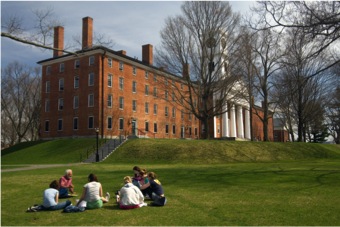

According to Forbes Magazine, Amherst College is the 13th best college or university in the United States.
It is not Amherst College’s most impressive ranking. However, it is not college ranking systems that I want to talk about. Rather, the subject of this column will be Forbes’ presentation of Amherst College.
In particular, I was struck by a link on Forbes’ webpage that brings viewers to a small photography gallery, meant to exhibit Amherst’s essence through a collage of images.
The primary image fits every appropriate stereotype. Outdoors. Resplendent day. College Row and an arresting angle of Johnson Chapel. A small circle of students focused on the wise words of a distinguished-looking professor in the foreground. Sufficient diversity of race and gender. It is the same image that, in essence, blankets every admissions brochure or formal request for alumni contributions.
Amherst, of course, is by no means alone in this love of the diverse outdoor classroom. A quick survey shows that Princeton University, the University of Chicago, Swarthmore College, Duke University and many other institutions use identical imagery to advertise themselves to prospective students on Forbes’ website.
Lest anyone believe that the choice of imagery belongs only to Forbes magazine, I point my readers to the website of the Amherst College Office of Public Affairs, which offers a publicly-accessible selection of “High Resolution Campus Stock” to media outlets and other interested parties. Eight images are available, two of which emphasize students. Both are of Amherst classes held outdoors. Forbes chose the more beautiful of the two.
Now, with my premise set, I move to exposition. These photographs are obvious lies. This is not to say that it is never the case that Amherst students find themselves taught by professors out of doors; after all, such events do occassionally occur. There are many reasons that they occur so rarely, but one stands at the forefront: Amherst is very cold in the winter.
Much as we upperclassmen like to reassure those newly come to Amherst that New England maintains sunny 75-degree weather in all seasons, Mother Nature has determined otherwise, and chilly winters do not conform to outdoor learning experiences. Walking around campus the last two weeks of Spring Semester, you will maybe see a class or two lounging in the open air, but outside of those two weeks, such a sighting is a near impossibility.
I call these photographs lies, then, because they misrepresent the day-to-day life of Amherst students, insinuating events for which the appropriate conditions rarely or never eventualize.
Lies though they are, these images do capture a truth about Amherst. They capture a love of learning, and in particular the mutual respect and goodwill shared between Amherst students and faculty. They capture Amherst’s scenic campus and the value we place on our natural surroundings. And the budding trees in the background capture the reinvention and renewal that characterize Amherst’s impact on its students. The picture has a certain amount of visual content that it truthfully articulates to viewers, and then it embellishes that content in the interest of visual appeal. That embellishment, of course, utilizes beauty.
Beauty, that most indescribable of visual properties, is most frequently used in advertising to layer onto and around the image’s content, making that content more positive and more powerfully displayed to its viewers. The picture’s content is the result of the picture’s real components: the students attentive to the professor, Amherst’s nature-filled campus, and the new growth of spring. Beauty results from the specific placement of these symbolic components in relationship to each other. Beauty weaves the image’s components into a display, drawing the eye to the right places and glorifying the result.
Advertising’s use of beauty accentuates one interesting property of beauty that distinguishes it from any other pleasure: it can be composed of symbols. Consider the pleasure of eating a yummy piece of pie. There is great pleasure involved in eating pie, but it would be difficult to add content to that pleasure, to use that pleasure in support of some sort of message or ideology. After all, sugar and fruits and crust may be the components of the pleasure of pie, but they have no meanings of their own. Beauty, on the other hand, is composed not only of constituent parts, but, in the case of art, those constituent parts themselves have understandable content.
Consider the relationship between the pleasure of pie and the pleasure of classical music. Classical music, like paintings, is frequently referred to as “beautiful,” whereas the taste of pie almost never receives that description. And classical music, again like paintings, holds significant symbolic meaning, as illustrated by the Kingdom of Heaven evoked by Beethoven’s 9th Symphony or by the leitmotifs that identify character from character in last year’s Academy-Award-winning movie “The Artist.”
Symbolic content also helps to explain the difference between, on the one hand, landscape paintings and classical music, and on the other hand, color-field paintings and trance music. All four art forms can offer significant pleasure, but it seems much more appropriate to attribute beauty to the former rather than the latter, and not at all to latter’s denigration. The pleasure of trance music seems much closer in feeling to the pleasure of yummy pie than it does the pleasure of Beethoven; here again, symbolic content provides the difference.
Ultimately, beauty’s symbolic building blocks result in beauty’s incredible potential as a tool of manipulation and propoganda, associating pleasure with whatever beautiful art happens to depict. In the Renaissance, beauty was the prime tool the Church used to instill faith in God and the heavens. Today, it is the prime tool of the Amherst College Office of Public Affairs, instilling faith in higher education and pleasant climates. Whatever beauty may be, it holds fundamental power over what we see and how we see it, and Amherst takes full advantage of beauty’s strength to promote its idealized self-image.
Previous articles from this column: On Beauty and Women